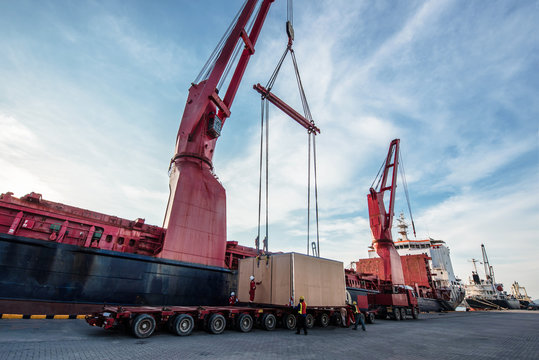In today’s globalized economy, the movement of oversized and heavy cargo plays a critical role in infrastructure development, industrial operations, and international trade. This category of logistics—known as heavy lift transportation—goes beyond traditional shipping by managing the movement of cargo that is too large, too heavy, or too complex for standard transport methods. As demand for such logistics services continues to grow across industries, the field of heavy lift transportation is revolutionizing the shipping industry. One of the most dynamic regions leading this transformation is the Middle East, especially through the advancement of heavy lift transportation in Saudi Arabia.

Understanding Heavy Lift Transportation
Heavy lift transportation refers to the planning, coordination, and execution of transporting massive and complex cargo such as turbines, oil rigs, transformers, industrial machinery, modular homes, and even entire bridge sections. These are often goods that exceed standard shipping dimensions or weights, requiring specialized equipment, detailed route planning, and expert execution.
It combines multiple logistics components—cranes, trailers, barges, air freight, and sometimes even rail—to ensure that these large and valuable pieces are delivered safely, efficiently, and on time. This service is critical in sectors like construction, oil and gas, mining, renewable energy, and aerospace.
Key Innovations Revolutionizing the Industry
1. Advanced Engineering & Route Planning
Modern heavy lift projects require sophisticated planning and simulation before a single item moves. Engineers now use advanced 3D modeling and digital route surveys to evaluate bridges, roads, and terrain before selecting the optimal path. This not only saves time and reduces risks but also ensures regulatory compliance in different jurisdictions.
In heavy lift transportation in Saudi Arabia, for instance, companies must navigate vast deserts, mountainous terrains, and urban zones while ensuring minimal disruption to public infrastructure. Such planning has become a cornerstone of the industry’s evolution.
2. Next-Generation Equipment
Specialized transportation vehicles and lifting equipment such as Self-Propelled Modular Transporters (SPMTs), hydraulic jacking systems, and high-capacity gantry cranes are now widely used in heavy lift logistics. These tools offer superior control, load distribution, and maneuverability—making it possible to move structures that were once considered immovable.
Saudi Arabia’s heavy industry, including petrochemicals and construction, is increasingly reliant on this technology to move massive components across the country and into neighboring Gulf states.
3. Digital Monitoring and Real-Time Tracking
Real-time monitoring through GPS and IoT sensors has made tracking heavy cargo much more accurate. Logistics managers can now detect movement anomalies, temperature fluctuations, and other critical variables that might affect the integrity of the cargo or the transport timeline.
This advancement is especially useful in heavy lift transportation in Saudi Arabia, where long distances between major industrial hubs demand constant oversight and communication.
4. Integration with Mega Projects
The rise of mega infrastructure and industrial projects such as NEOM, Red Sea Global, and the Riyadh Metro has significantly driven demand for heavy lift logistics. These initiatives often require the transportation of massive prefabricated units, machinery, and energy infrastructure across remote areas.
Heavy lift transportation has adapted to meet this need, integrating seamlessly with project timelines and providing end-to-end delivery from ports to inland destinations—helping Saudi Arabia meet its Vision 2030 logistics and industrial diversification goals.
Challenges in Heavy Lift Transportation
Despite its growth and innovation, heavy lift transportation comes with significant challenges:
- Regulatory Approvals: Multiple permits and clearances are required at different stages of the journey, especially when crossing provinces or national borders.
- Safety Risks: The sheer weight and size of cargo demand exceptional attention to safety. Any error can lead to multi-million dollar losses or catastrophic incidents.
- Infrastructure Constraints: Many roads, bridges, and terminals are not designed to handle ultra-heavy cargo. Extensive coordination with government agencies is often necessary to make the journey possible.
- Environmental Impact: The fuel and emissions associated with moving large cargo can be substantial. Newer technologies are now aiming to reduce the carbon footprint of these operations.
Why Saudi Arabia Is Emerging as a Heavy Lift Hub
Heavy lift transportation in Saudi Arabia is witnessing unprecedented growth due to the Kingdom’s massive investments in infrastructure, energy, and industrial development. Its strategic location, growing seaport capabilities, and expansion of inland logistics networks make it a natural leader in the region.
Key factors driving the growth include:
- Industrial Diversification: As part of Vision 2030, Saudi Arabia is reducing its dependence on oil exports by building world-class manufacturing and logistics zones.
- Oil & Gas Industry: Saudi Arabia's petroleum sector requires regular movement of massive machinery, refining units, and drilling components across deserts and coastal areas.
- Construction Boom: From stadiums to smart cities, mega-projects are driving demand for specialized logistics services that only heavy lift transportation can provide.
- Port and Road Upgrades: Investments in infrastructure are making it easier and more efficient to move oversized cargo from port to project site.
Future Outlook: What’s Next?
The future of heavy lift transportation is closely tied to advancements in automation, digital twins, AI-based route planning, and sustainability measures. Companies that embrace these technologies will stand out in an increasingly competitive market.
In regions like Saudi Arabia, where the scale and ambition of development projects are unmatched, heavy lift transportation will continue to evolve as both a critical enabler and a competitive advantage.

Conclusion: UBLCO – A Trusted Leader in Heavy Lift Transportation in Saudi Arabia
When it comes to delivering excellence in heavy lift transportation in Saudi Arabia, UBLCO has emerged as a trusted industry leader. Known for its engineering precision, advanced equipment fleet, and commitment to safety, UBLCO supports mega infrastructure and industrial projects with unmatched expertise. Whether moving cargo from port to remote construction sites or navigating complex regulatory frameworks, UBLCO ensures your heavy cargo arrives securely and efficiently. As the industry transforms, UBLCO remains at the forefront—powering progress across the Kingdom and beyond.


